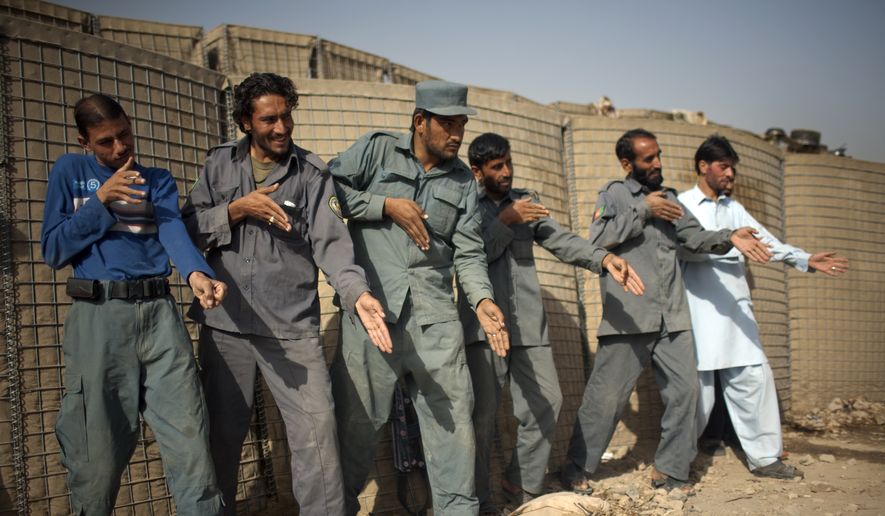The Pentagon spent more than $84 billion over two decades to train and arm the Afghan national security forces, and large numbers of U.S. arms and equipment are now in the hands of the Taliban, a spokesman said Thursday.
Pentagon spokesman Maj. Rob Lodewick declined to provide a breakdown of the $84.3 billion estimated to have been spent over the 20-year Afghan combat mission, an expenditure that could not prevent the collapse of the 300,000-troop Afghan National Defense and Security Forces (ANDSF) at the hands of the Taliban insurgency. U.S. officials are playing down the amount and quality of the weaponry and other gear left behind with the formal departure on Aug. 31.
“While large numbers of ANDSF weapons and equipment are likely to now be in Taliban hands, it’s important to remember that this equipment was intended to fight a low-tech insurgency,” Maj. Lodewick said. “It is not the type of equipment that will be of great strategic use to any force, and does not represent a significant threat to U.S. forces or the militaries of neighboring countries.”
The U.S. military also left behind arms stocks and equipment, including some precision-guided munitions, when it abandoned the Bagram air base, according to a defense source.
President Biden attributed the military collapse to a lack of will and leadership on the part of the Afghan army.
An Aug. 23 report by the Congressional Research Service estimated that U.S.-supplied arms and equipment to Afghan forces just between fiscal year 2003 and fiscal year 2016 included some 600,000 weapons, including rifles; 163,000 tactical and nontactical radios; 76,000 vehicles, such as Humvees; 30,000 pieces of equipment used in detecting and disposing of explosives; 16,000 pieces of gear used for intelligence, surveillance, and reconnaissance; and 208 aircraft, such as helicopters.
“The swift collapse of the Afghan National Defense and Security Forces (ANDSF)… has prompted questions about U.S. security assistance in Afghanistan and beyond,” the report said.
The report said the U.S. military has been carrying out airstrikes in a bid to destroy some of the U.S. equipment from being stolen by the Taliban. Reports from the region have shown Taliban fighters with U.S. weapons and driving police vehicles and Humvees from the Afghan army.
“To avoid Taliban capture, members of the ANDSF have reportedly flown U.S.-provided military aircraft and driven armored vehicles and pickup trucks into neighboring countries,” the report said. “Other reports suggest that many of the ASSF commandos who refused to surrender to the Taliban are now being targeted and some have joined a nascent resistance.”
The CRS report said the U.S. government provided $144.98 billion from 2005 through June 2020, including military, humanitarian and development funding.
Within that amount, $88.61 billion was provided for security assistance, mainly through the Afghanistan Security Forces Fund (ASFF), which received $82.90 billion along with $5.71 billion provided through foreign military financing, international military education and training, peacekeeping operations, and “drug interdiction and counter drug activities.”
The report said government reports from 2020 and this year revealed increasing pressure on the Afghan army from the Taliban and declining readiness of the Kabul government forces, which also include the national police.
The swift collapse also appeared linked to what the CRS said were “more deeply rooted missteps and strategic misassumptions over two decades.” Systemic issues in the Afghan army include “a corrupt chain of command, significant rates of desertion and attrition, a lack of leadership, and widespread illiteracy,” the report said.
The report also noted that U.S. military training and equipping “overemphasized tactical skills and neglected higher-level expertise, forced the ANDSF to be heavily reliant on airpower and technology that Afghans could not maintain independently, and excluded Afghan involvement or input in equipping decisions.”
The Afghan air force also declined after the withdrawal earlier this year of U.S.-funded contractors.
Reports from Afghanistan indicated that the Afghan army soldiers negotiated surrenders with the Taliban or kept their weapons and joined the Islamist group.
The fall of the Afghan army also means that the fiscal 2022 budget request of $3.3 billion can be reprogrammed for other uses.
A report by the office of the secretary of defense in 2020 justifying the budget for Afghanistan military spending also reveals the extent of military and intelligence equipment supplied to the Afghans.
“The Afghanistan Security Forces Fund (ASFF) is the center of gravity of the Department of Defense (DoD) mission in Afghanistan and undergirds the U.S. commitment to an enduring defense partnership with Afghanistan,” the report said.
The funds were needed “to sustain high-tempo combat operations against a resilient insurgency and be a reliable counterterrorism partner with the United States,” the report said. “The U.S. vital national security interest in Afghanistan is to prevent it from again becoming a safe haven for violent extremist organizations to plan and stage attacks against the homeland, our allies, and partners.”
The $4 billion in funding for that fiscal year was needed to keep the Afghan military and security forces “on a path of increasing professionalism, effectiveness, and sustainability.” The 2021 budget also included $29.1 million for women in the Afghan military and within security ministries.
According to the Pentagon report, funding was used for all elements of running a military — fuel and logistics, intelligence, communications and night vision equipment, automatic rifles, machine guns and ammunition.
More than $44 million was spent on an Afghan Automated Biometrics Info System. The system is used to store and manage biometric data on Afghan troops.
“The system provides enhanced searching, matching, storing, and analysis capabilities; increased capability for biographical, finger, facial image, iris, and palm print matching,” the report said.
In the hands of the Taliban, the system can now be used to identify and purge the 300,000 troops of the Afghan army.
• Bill Gertz can be reached at bgertz@washingtontimes.com.




Please read our comment policy before commenting.